

Matt Campbell
2026 Hyundai Tucson Hybrid review
6 Hours Ago
These two semi-premium, high-riding crossovers fall nicely in between conventional hatchbacks and practical SUVs.

Senior Contributor
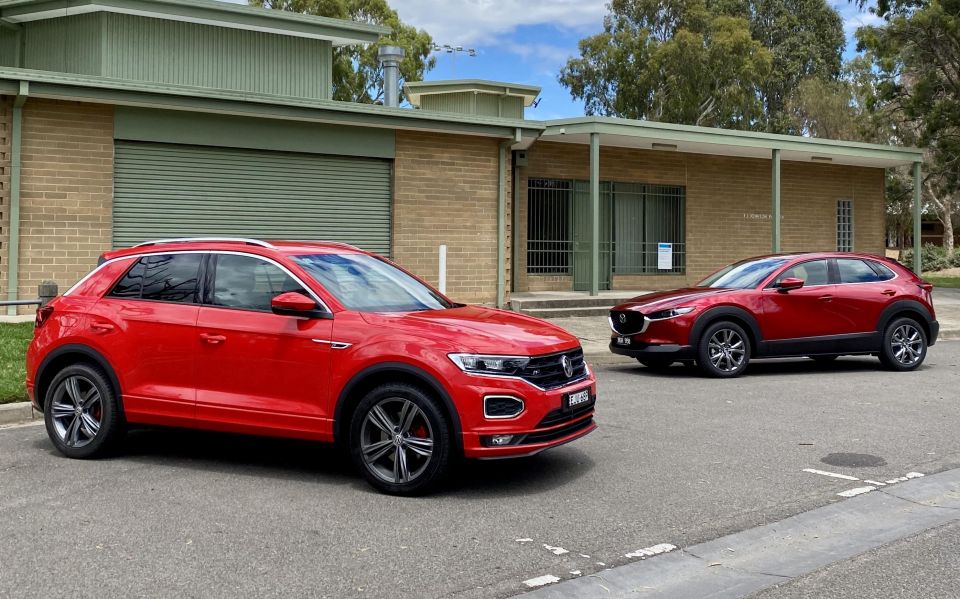

Senior Contributor
The Mazda CX-30 and Volkswagen T-Roc don’t share all traits, but at heart they occupy a space in the market between traditional hatchbacks and more practical, ‘conventional’ SUVs.
These crossovers give you a smidge more clearance and a bolder look than the former, but are more ‘car-like’ than the latter. Both turn heads and want for little when it comes to tech.
Furthermore, both Mazda and Volkswagen are brands with vaguely premium aspirations. Neither purports to be Mercedes-Benz, but they do market themselves as being a cut above the mainstream set – rightly or wrongly.
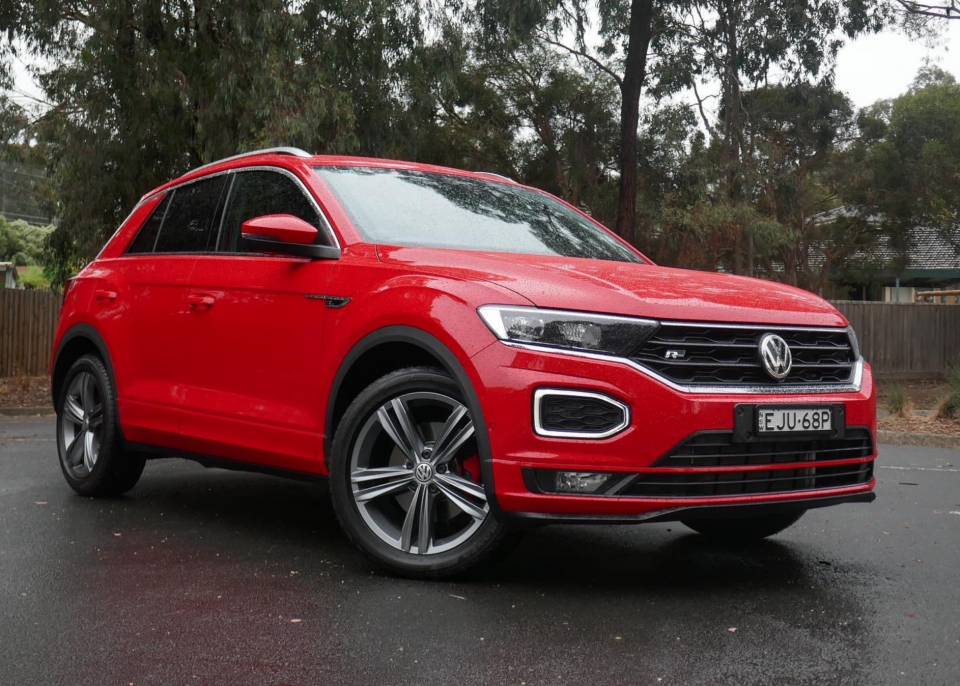
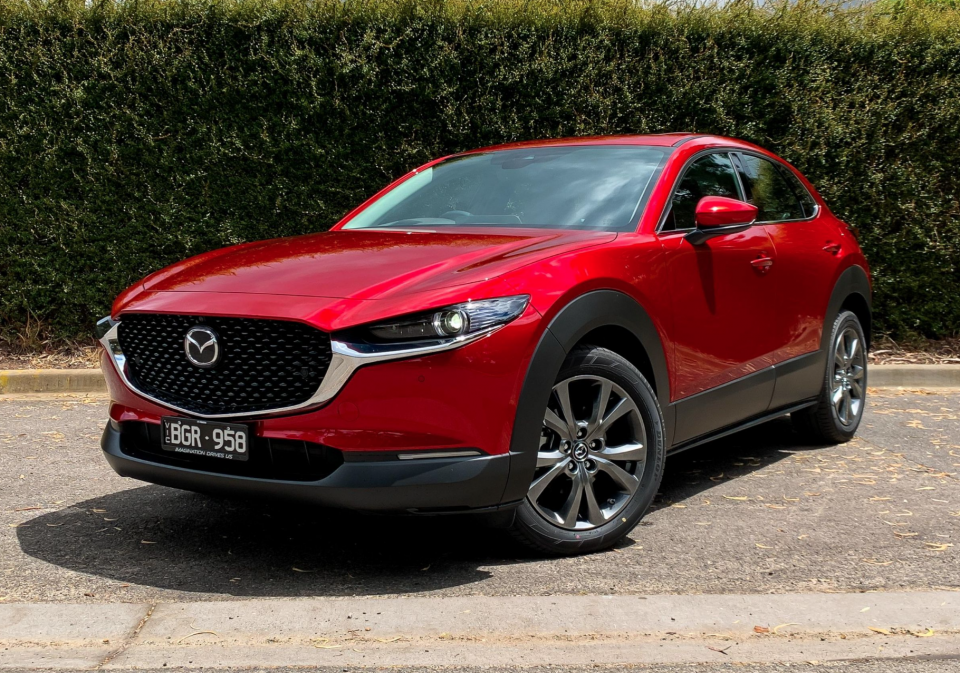
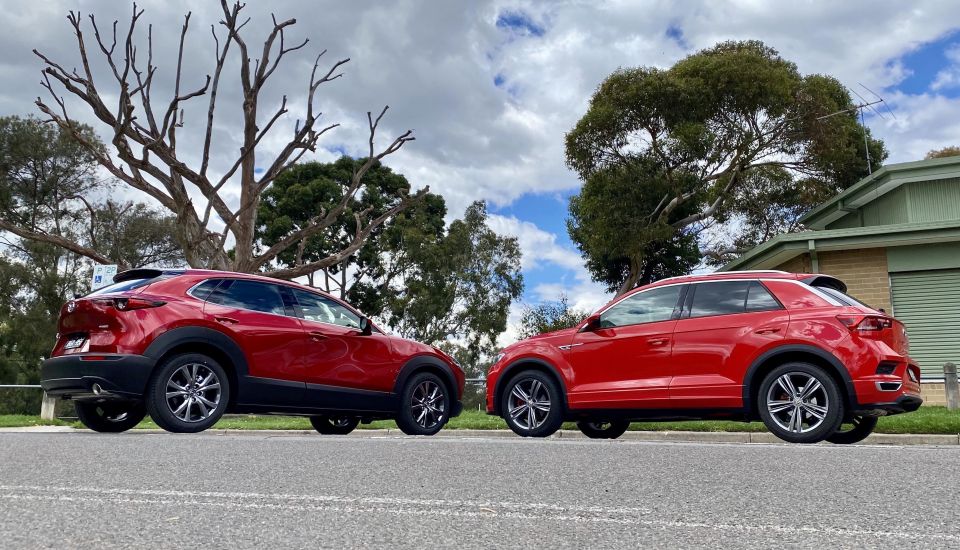
The entry grade Volkswagen T-Roc 110TSI Style (33,990 before on-road costs) soon to go on sale will nab the budget buyers, but here we have the T-Roc 140TSI Sport that retails for $40,490before on-road costs, equal to about $45,700 drive-away depending on where you live.
The Mazda CX-30 range kicks off at $28,990 for the G20 Pure, but the version we have here is the range-topping Astina with the newly launched X20SkyActiv-X engine. Its list price is $46,490, which equates to an estimated drive-away price of $51,800.
For reference, the CX-30 Astina with the more familiar 2.5-litre (non-SkyActiv-X) petrol engine is $3000 cheaper.
| Mazda CX-30 X20 Astina | Volkswagen T-Roc 140TSI | |
|---|---|---|
| List price before options | $46,490 | $40,490 |
| Drive-away estimate | $51,800 | $45,700 |
There are just two full-time T-Roc engine and spec levels on offer, whereas the far wider CX-30 range comes with three engine choices, and four specification levels – Pure, Evolve, Touring, and Astina.
It’s worth noting this outlay will get you a decent-spec Mazda CX-5 or Volkswagen Tiguan, both of which are infinitely more practical, but less stylistically adventurous.
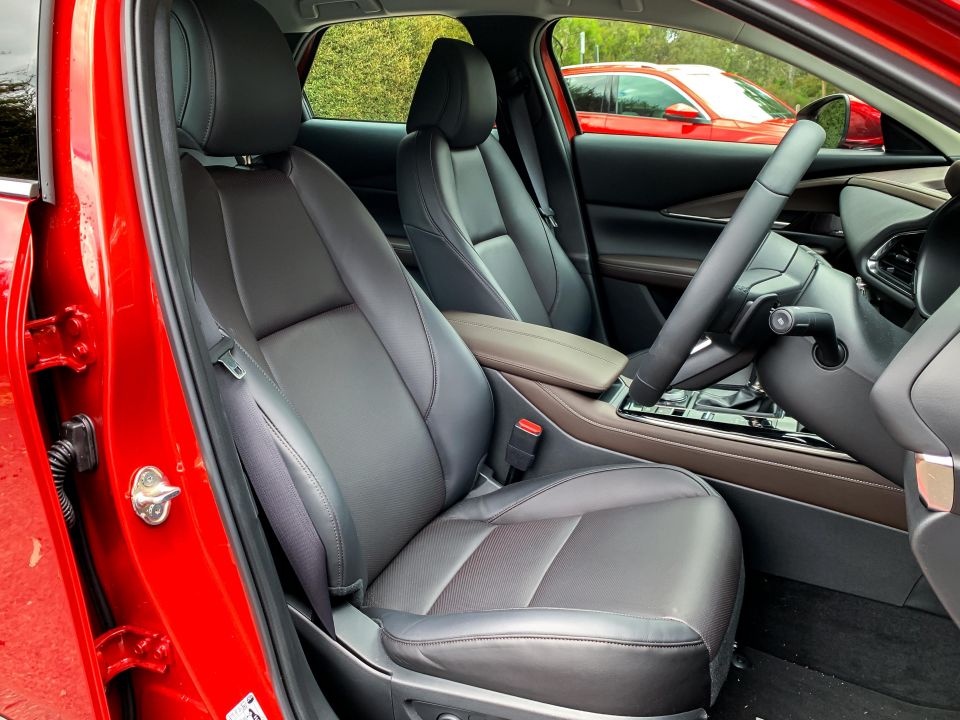
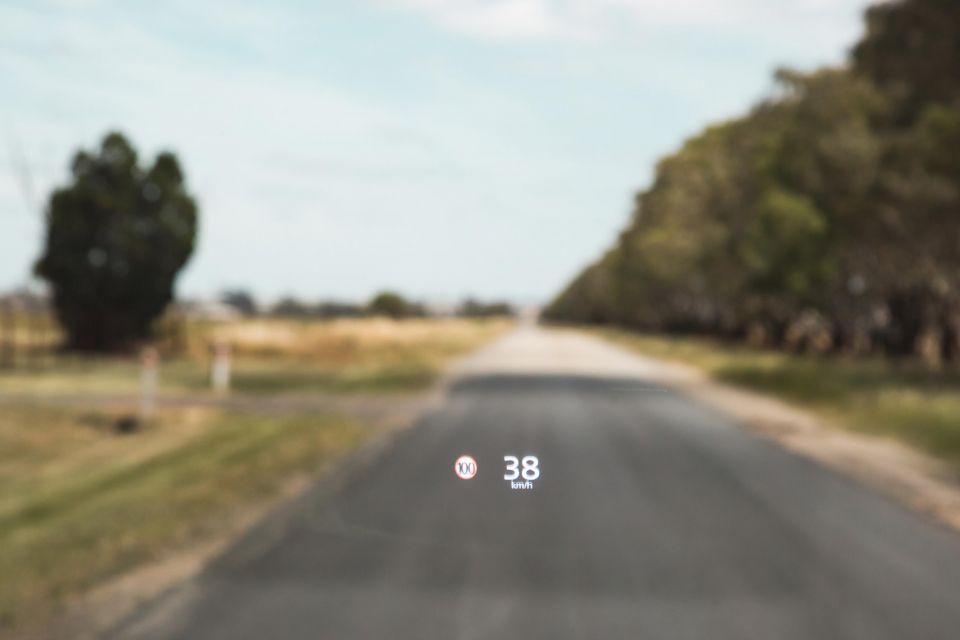

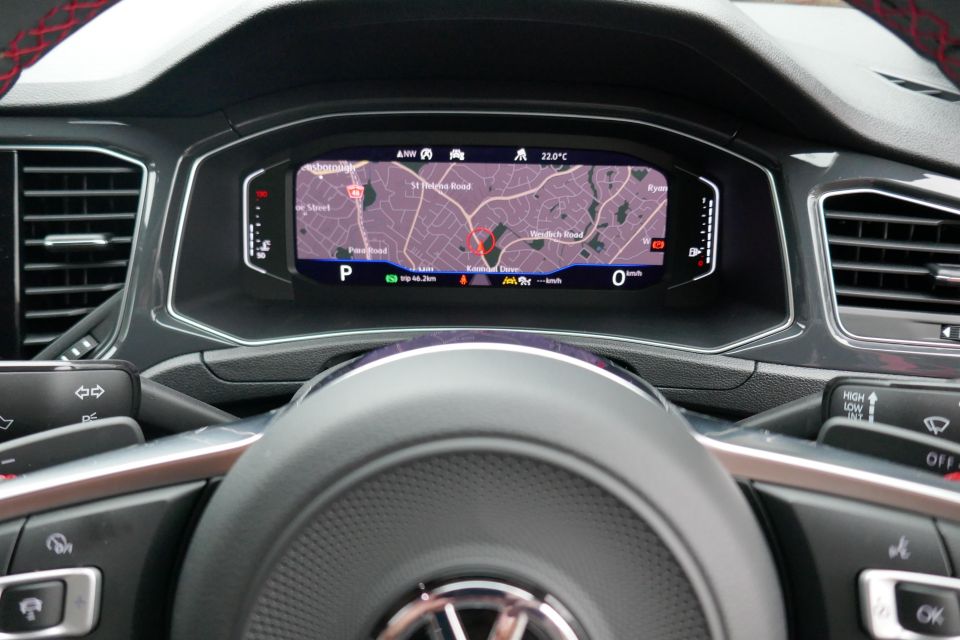
Standard fare on each include 18-inch wheels, LED headlights and tail lights, proximity key access, and rain-sensing wipers.
Inside, each gets dual-zone climate control, satellite-navigation, Apple CarPlay and Android Auto, along with an auto-dimming rear-view mirror. The Mazda gets a head-up display whereas the Volkswagen counters with fully digitised driver’s instruments.
There are some differences at face value. The CX-30 Astina justifies its $6000 greater list price with extras not found standard on the T-Roc including a powered tailgate, a sunroof, leather seat trim, heated front seats, a Bose 12-speaker audio system, and a 360-degree camera.
But there’s a method to my decision to test two cars with such a price gap: extra-cost options. There are two packages you can add to the Volkswagen, which were not fitted to our test car but which even things up nicely.
First there’s the $2000 Sound and Style Package that adds 19-inch wheels, an uprated 300W Beats audio system, and adaptive dampers that change the ride stiffness at the press of a button. Then there’s the $3500 Luxury package that adds a panoramic sunroof, leather seats, and a powered tailgate.
If you were to add these, the list price of your T-Roc 140TSI Sport would come to $45,990, or $500 less than the flagship Mazda. If you’re wondering what the ‘fully loaded’ T-Roc looks and drives like, we’ve filmed it here.

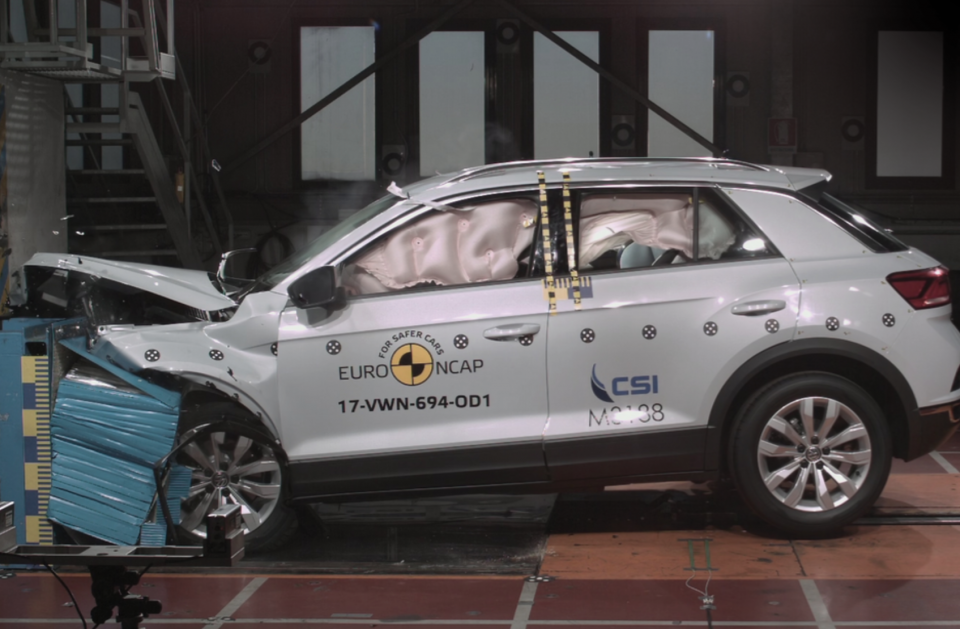
Both get dual front, front-side, and full curtain airbags, plus the Mazda adds a driver’s knee ‘bag. Each also offers two ISOFIX and three top-tether child seat anchor points.
Active safety systems found on both includes forward autonomous emergency braking (AEB) with pedestrian detection, lane-departure alert, lane-keeping aid, blind-spot monitoring, rear cross-traffic alert, driver monitoring, dipping kerbside mirrors, and front/rear parking sensors.
The Volkswagen offers automated Park Assist, while the Mazda alone adds reverse AEB, forward cross-traffic alert, and cyclist detection in the AEB.
I should also note here that Mazda’s lane-keeping aid felt less proficient and predictable than Volkswagen’s, which also proved able to jolt the brakes if the driver failed to take over the steering after a dedicated interval of time.
Both carry five-star ANCAP ratings, calculated using data from European NCAP testing. The CX-30 scored five stars in 2019 whereas the Volkswagen scored five against the 2017 criteria because that’s when it launched overseas.
We must make mention of the CX-30’s extraordinarily good 99 per cent score for Adult Occupant Protection – though the VW’s 96 per cent score ain’t too shabby either!
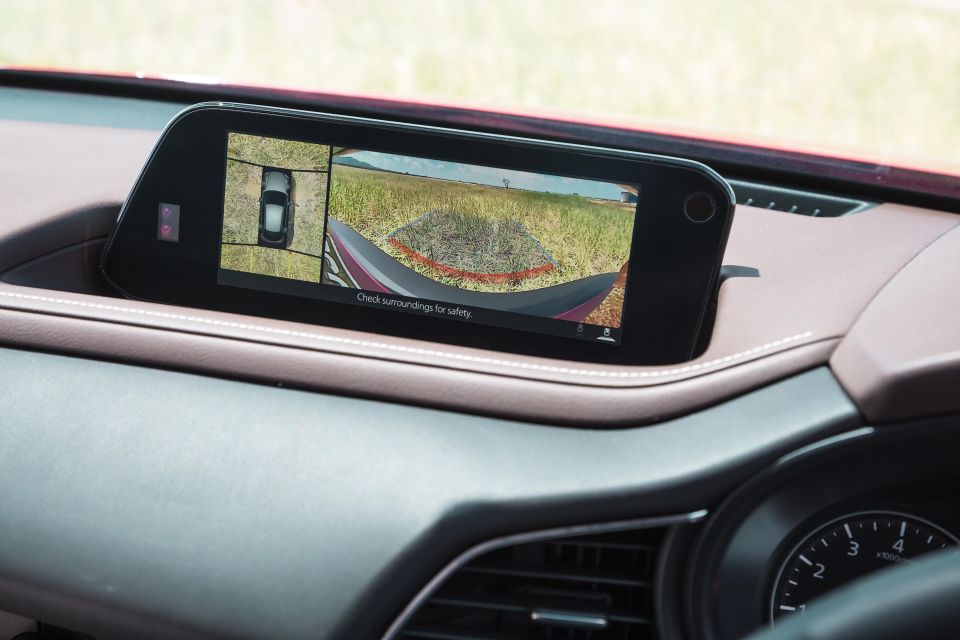

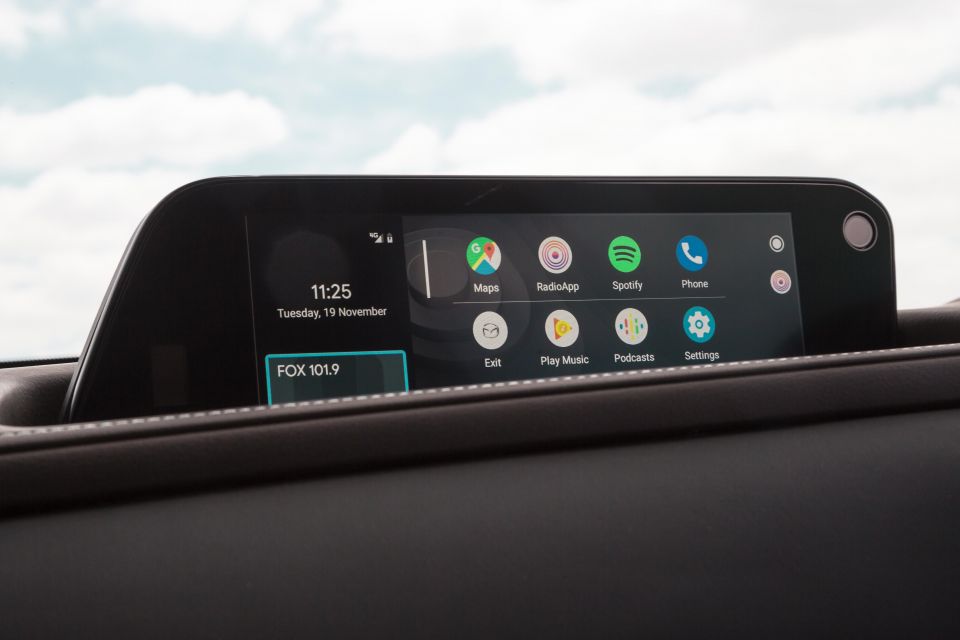
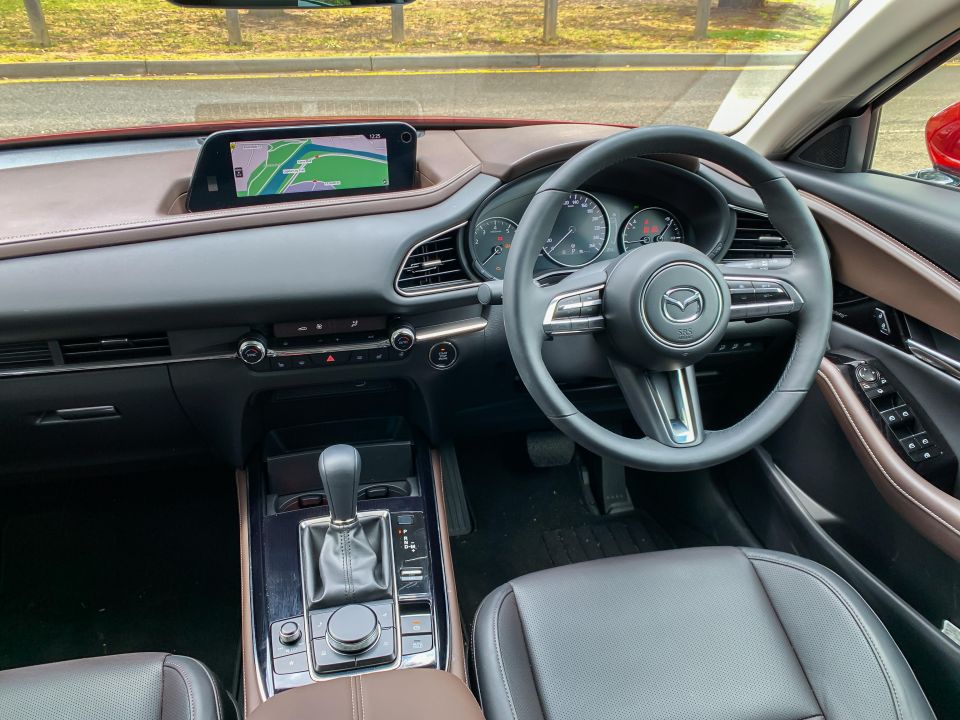
Mazda
In a word, ‘plush’. Mazda has gone to great lengths to impart a feeling of luxury in here, with seemingly every surface you may touch covered in soft plastics or leather – much of it accented in light brown to offset the sumptuous black seat trim.
You sit quite low, behind a really tactile thin-rimmed steering wheel. Ahead of you are clear analogue instruments and a central speedometer flanked by wraparound air vents, and dead-ahead there’s a head-up display projecting your speed and navigation instructions onto the windscreen.
The quality of the window switches and air conditioning dials, to use two examples, are Audi-lite, and the minimalist driver-focused design really floats my boat.
The infotainment system is a hundred leagues ahead of Mazda’s previous incarnation in terms of graphics and usability, with good-resolution maps and nicely detailed sub menus. The Bose sound system is also a cracker, with good sound quality aided by plenty of NVH suppression.
That said, it’s not operable as a touchscreen at all – you use a rotary dial and buttons between the seats instead – and while this is less distracting as you drive and in my opinion a good solution more often than not, it doesn’t bring out the best in Apple CarPlay interfacing.
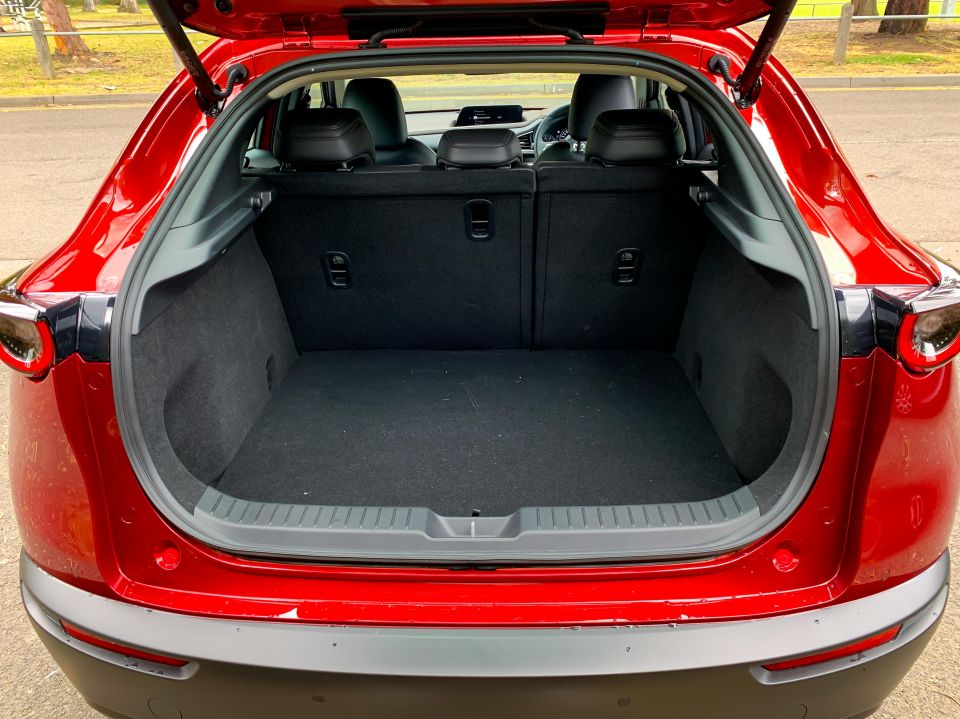
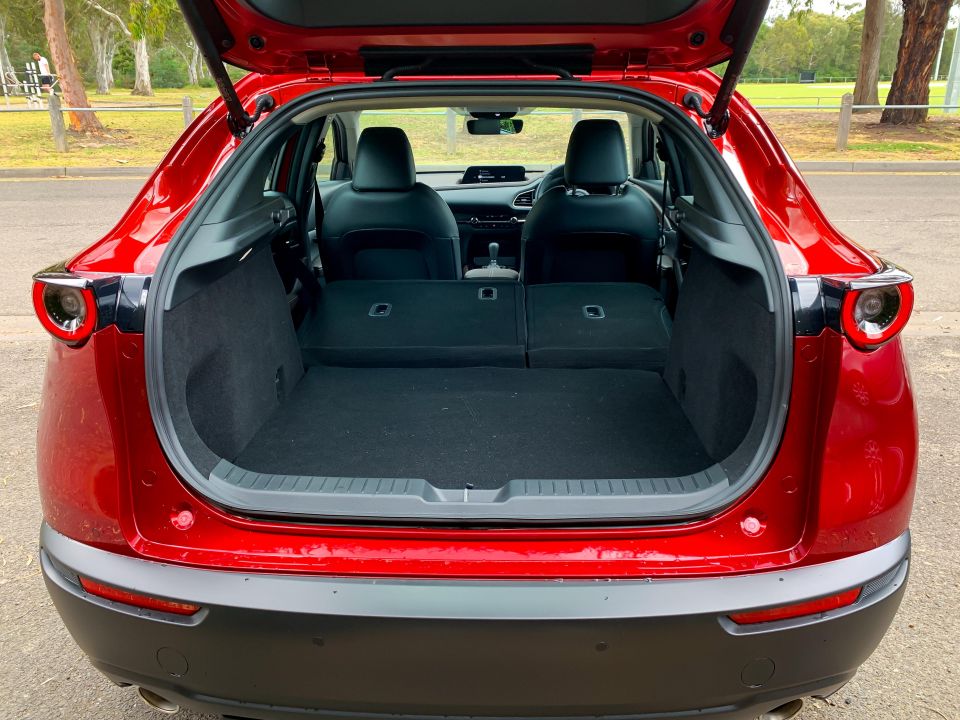
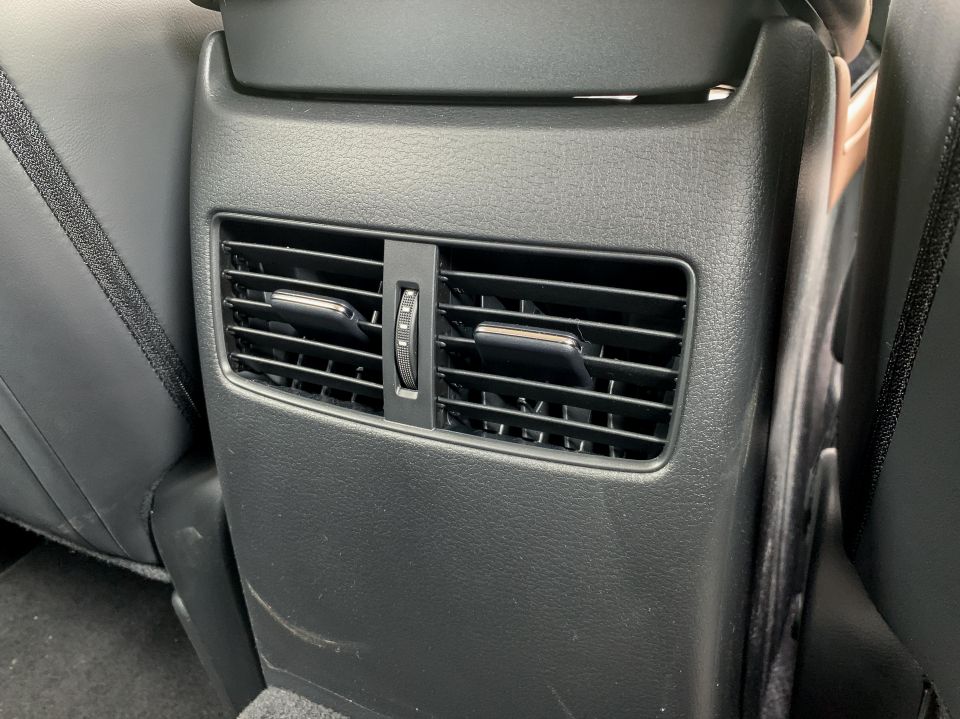
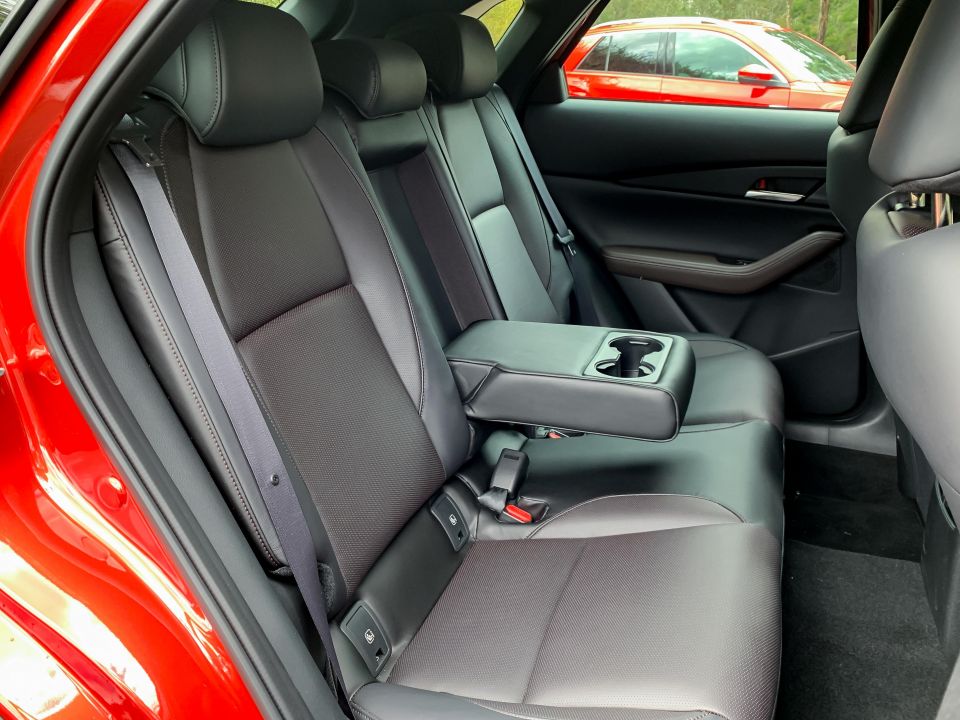
Storage is pretty good, with cubbies in the doors that will hold large bottles, a shelf under the centre stack that will hold a large phone, two decent-sized cupholders, and a bin under the centre armrest.
Negatives? Well, there’s lots of shiny black surfaces along the transmission tunnel that immediately show up dust, smudges, scratches and sun glare. And the air-conditioning system felt a little underdone battling the first properly warm day of a Melbourne summer – perhaps it’s the vent placement?
The CX-30 isn’t the last word in rear passenger accommodation, though its larger side windows make it more pleasant back there than a Mazda 3 hatch. I’m 194cm and found limited knee- and head room, though anyone below 180cm will manage well enough, and kids certainly will.
Passengers will appreciate the fold-down centre armrest with cupholders, rear air vents, and bottle holders in the doors. There are no USB or 12V outlets like in the front, so friends in the back can’t charge mobile devices.
The luggage area doesn’t really shine on paper compared to rivals, either. Mazda claims just 317L of capacity in five-seat layout, which is low even for a regular hatchback let alone an SUV. Under the boot floor you’ll find a space-saver spare in all CX-30 models.
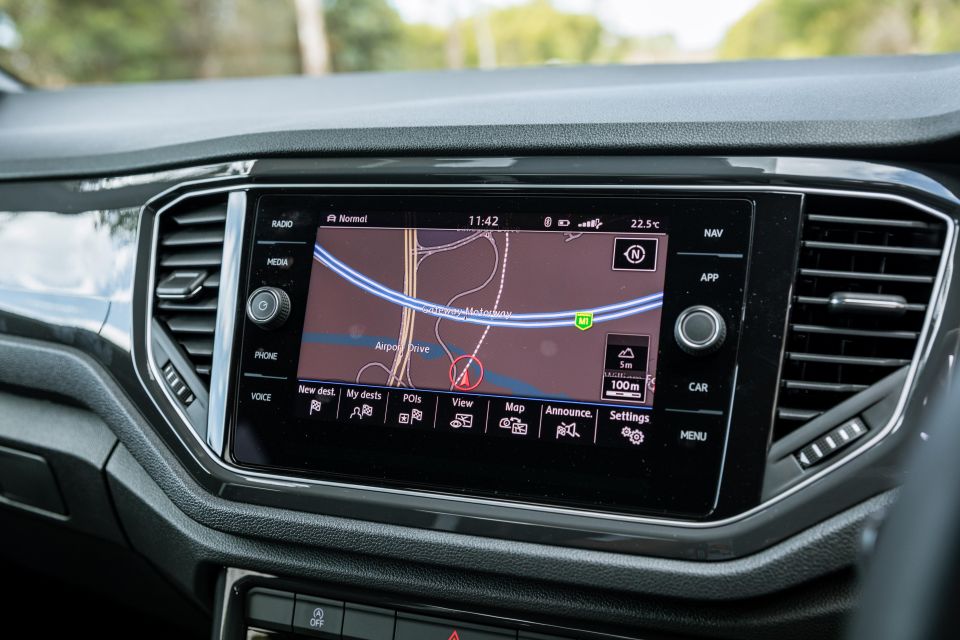

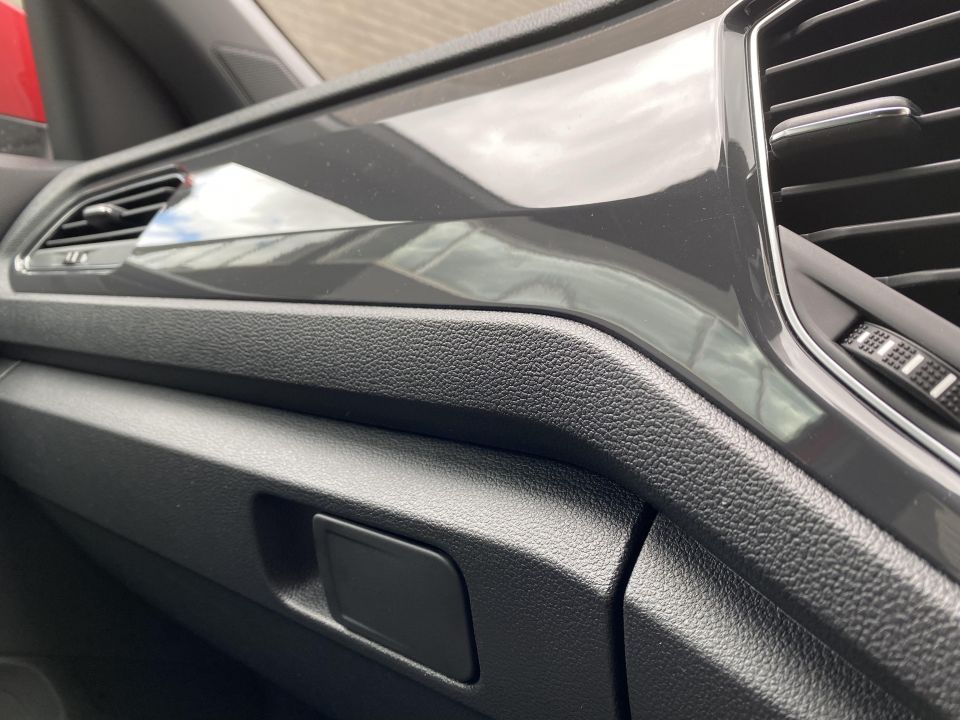
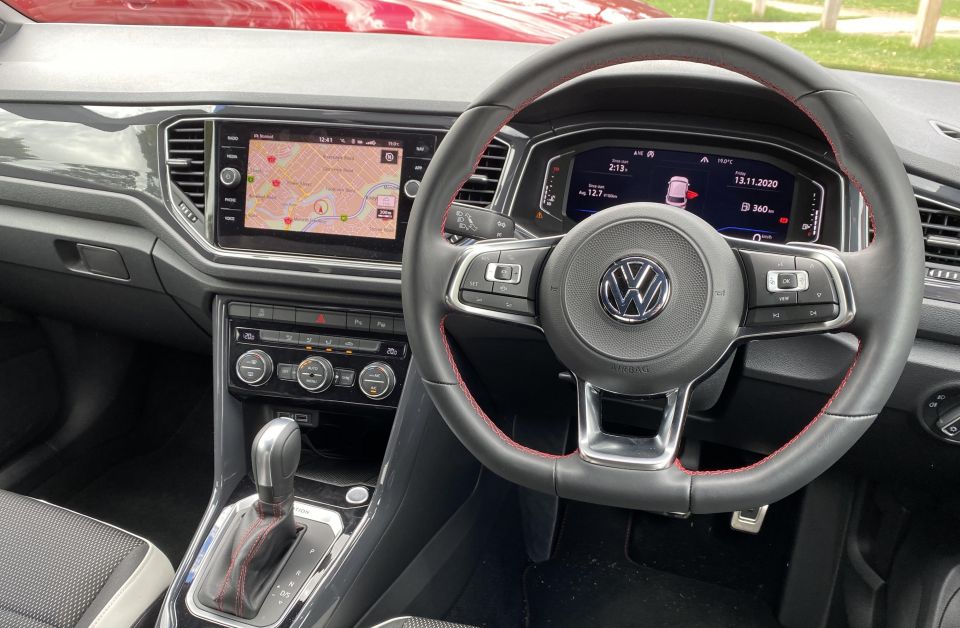
Volkswagen
The Volkswagen makes a higher-tech first impression, on account of the impressively large digital instrument cluster than can show full-width detailed maps, or various driver data layouts. It’s very configurable and loads quickly, and therefore is a nice substitute for a HUD.
The Golf GTI-like steering wheel is lovely, though the buttons aren’t as tactile as the Mazda’s. The red stitching adds a sporty vibe, and in typical Volkswagen style there are endless seat and wheel adjustments to ensure anyone can get themselves situated nicely.
The centre touchscreen is simple to operate and accommodates smartphone-like swiping, ensuring the tech package in here is as contemporary as you’d demand.
The funky black-and-white seats are very comfortable, especially for those of us who actually prefer cloth, and offer decent support through corners. cabin storage is also as capacious as the CX-30’s, though I miss the felt-lined door bins that a Golf has…
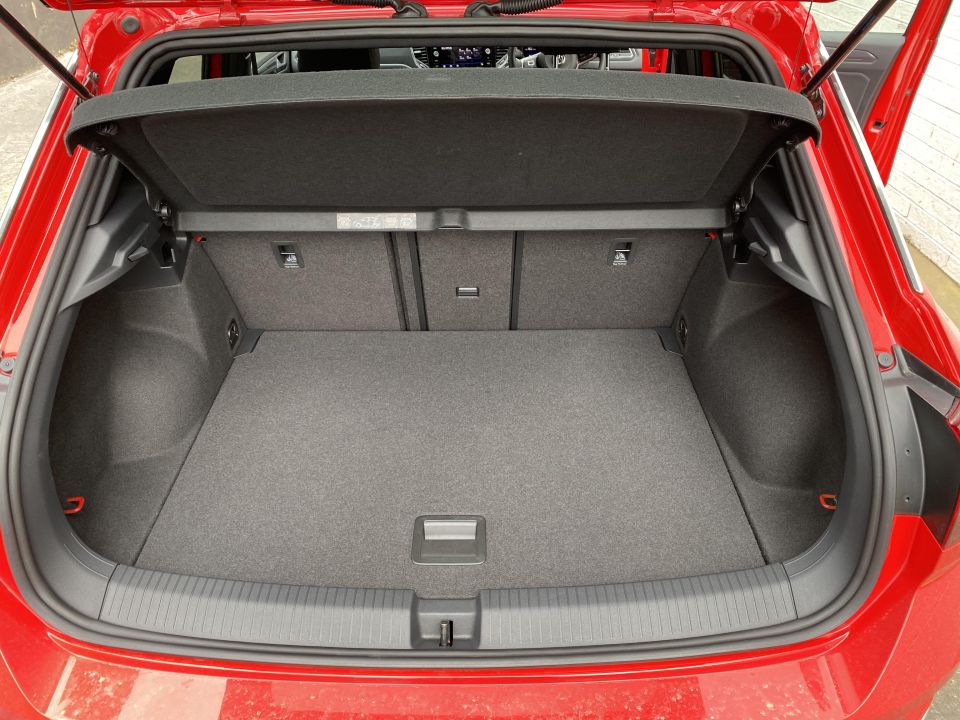
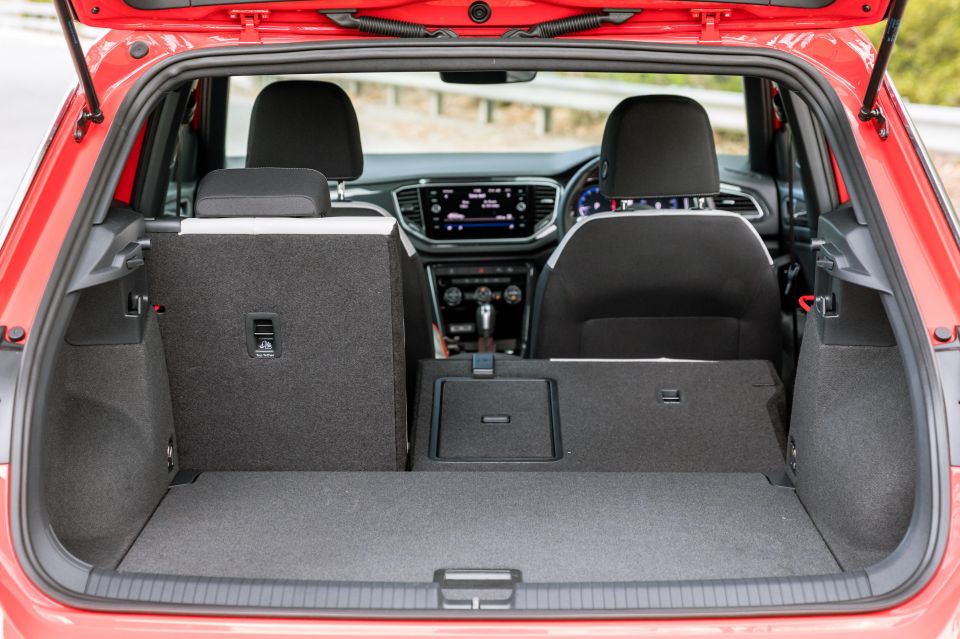
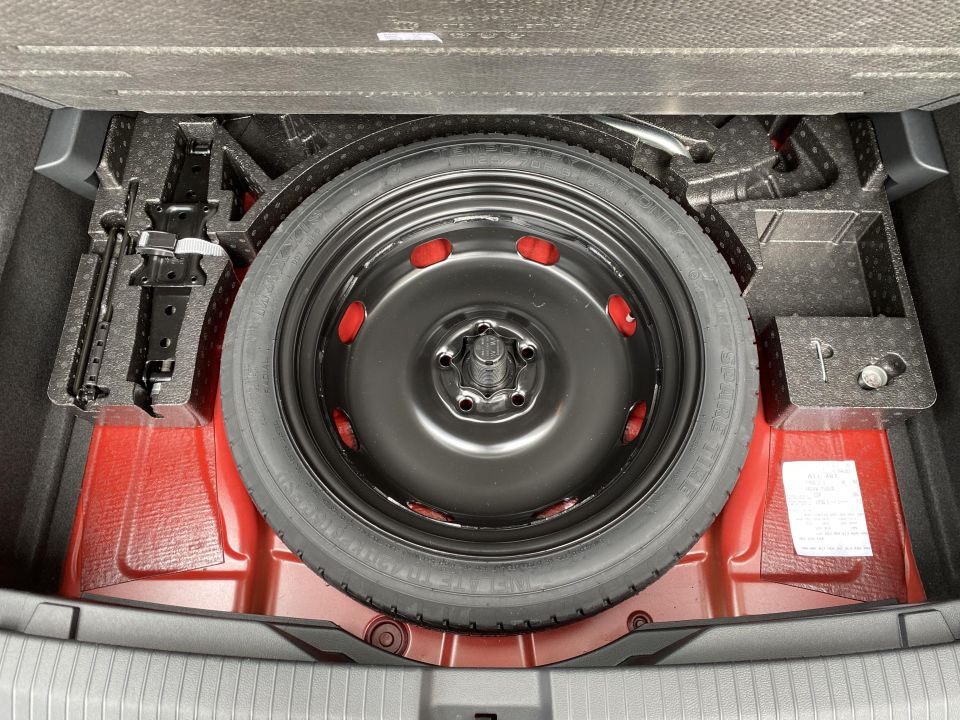
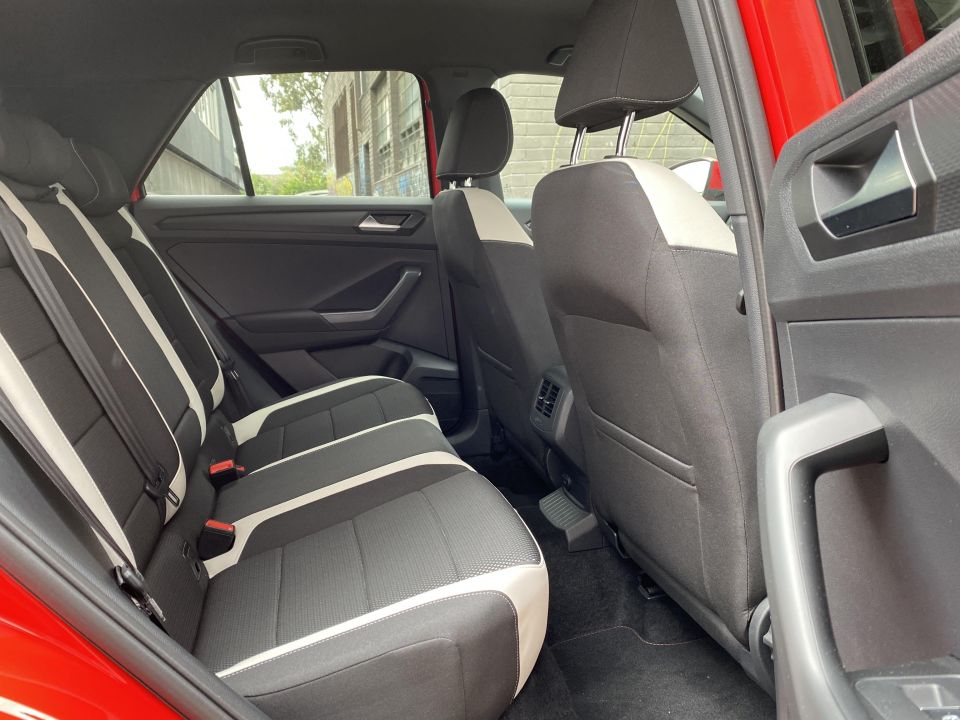
On that note, I don’t love the expanse of cheap-looking, hard plastic adorning the dash, door cards, and centre tunnel. Volkswagen should not simultaneously aspire to offer an experience that’s “Premium for the People” while serving up low-grade trims. It’s un-VW.
While it’s the shorter car on test, the back seat accommodation was sufficient for my long legs and torso to fit behind my own preferred seating position – just. The lack of standard sunroof helps headroom too. The seat backs are also nicely raked and the windows let plenty of light in.
The door trims are crummy like those up front, but the actual build quality is harder to fault throughout. There’s a decent amount of door storage, and both rear vents and a 12V socket that you can fit a USB adaptor into.
Carrying capacity is better than the Mazda, with more boot space (392L), and the load height is ideal for sliding in heavy grocery bags on account of its lower running clearance.
In short, the Volkswagen offers flashier cabin tech even without the added options, and more space, but the Mazda’s cabin is made with better materials and attention-to-detail.
| Mazda CX-30 X20 Astina | Volkswagen T-Roc 140TSI | |
|---|---|---|
| Length | 4395mm | 4246mm |
| Width | 1795mm | 1819mm |
| Height | 1540mm | 1572mm |
| Wheelbase | 2655mm | 2595mm |
| Tare weight | 1525kg | 1461kg |
| Ground clearance | 180mm | 158mm |
| Boot capacity | 317L | 392L |
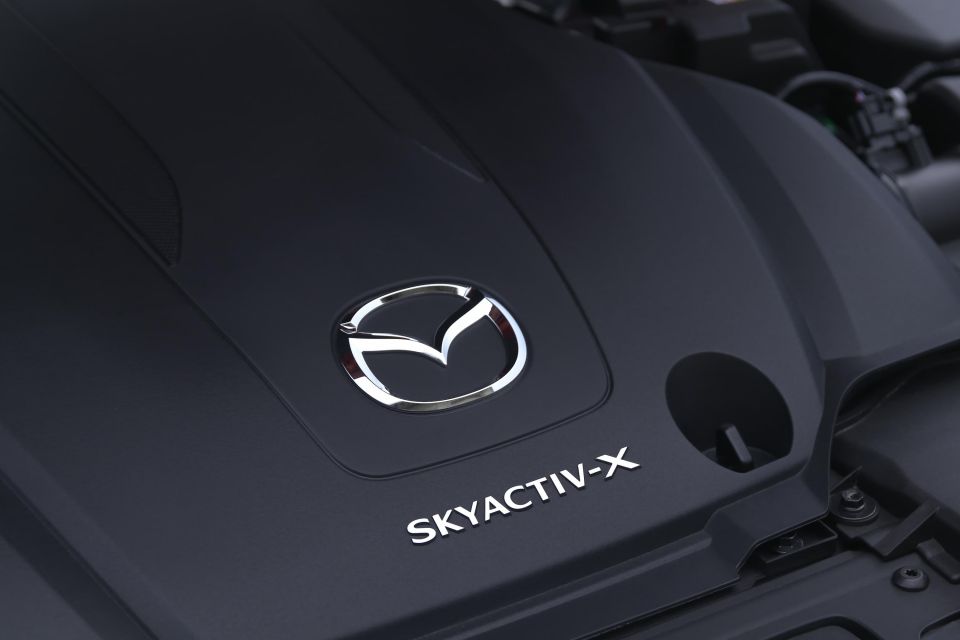
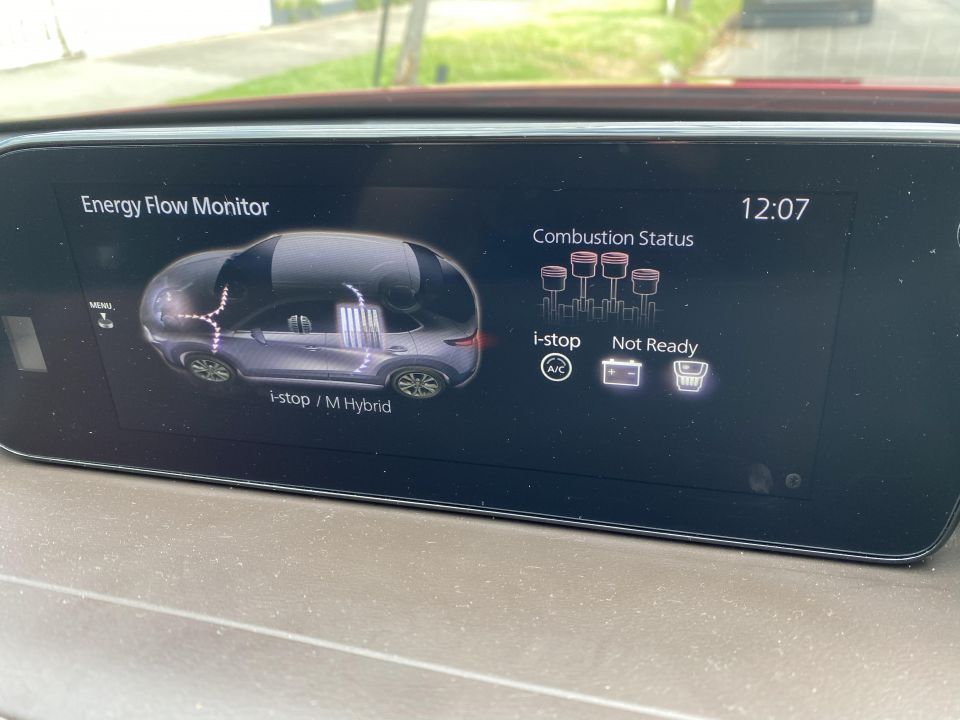
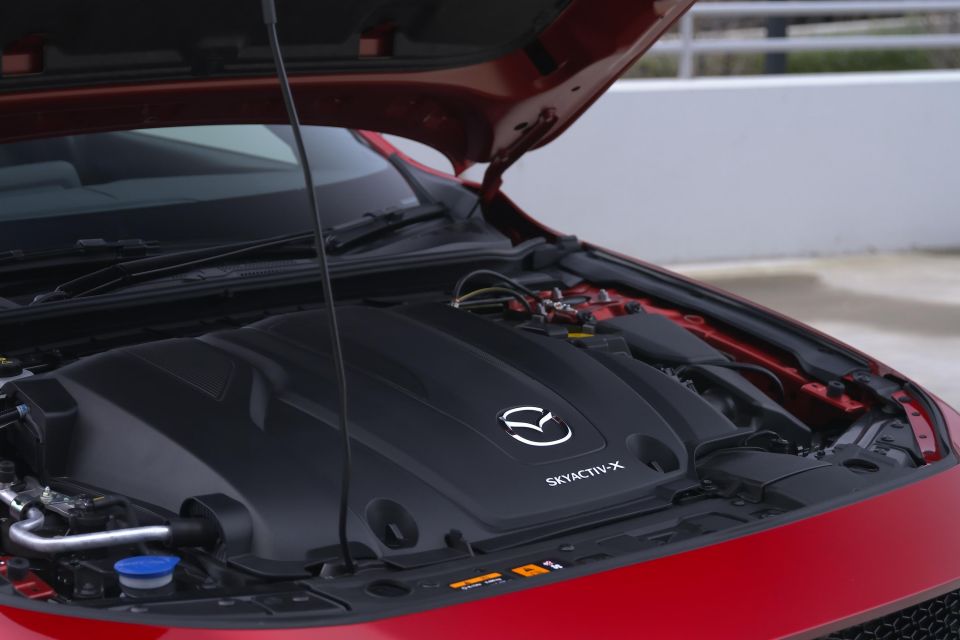
Mazda
The Mazda’s ‘SkyActiv-X’ engine is at its core a high compression-ratio (15:1) 2.0-litre (lightly) supercharged unit with four cylinders. However, it also has a system called Spark Guided Controlled Compression Ignition.
When operational, the spark ignites just a bit of the lean fuel-air mixture in each cylinder, which raises the temperature enough so the remaining mixture can ignite under pressure, like a diesel. Moreover, energy is recuperated when you decelerate and stored in a 24V battery to smooth out the stop/start system.
The engine is paired as standard in CX-30 guise to a six-speed automatic transmission with inbuilt Sports mode for slicker downshifts, and on-demand front-biased ‘i-Activ’ all-wheel drive (AWD).
The company claims it offers “the efficiency of a diesel”, and it applies an ‘M Hybrid’ tag on account of the electrical system.
Power is rated at 132kW at 6000rpm, and torque is 224Nm at 3000rpm. By contrast the ‘regular’ 2.0-litre engine found in front-drive G20 CX-30 models makes a more modest 114kW and 200Nm, while the AWD models with the 2.5-litre naturally-aspirated petrol make 139kW and 252Nm.
The SkyActiv-X’s official fuel consumption is 6.0 litres per 100km on the combined cycle, compared to 6.5L/100km for the normal 2.0-litre and 6.8L/100km for the 2.5-litre. However, unlike the latter pair that’ll drink 91 RON or E10, the SkyActiv-X needs premium 95 RON.
So once you put the claims to one side, it’s neither as torque-laden or efficient on paper as many small diesels, or as fuel efficient as a Toyota hybrid with a drive battery. One might imagine Mazda plans to evolve the technology as time goes by.
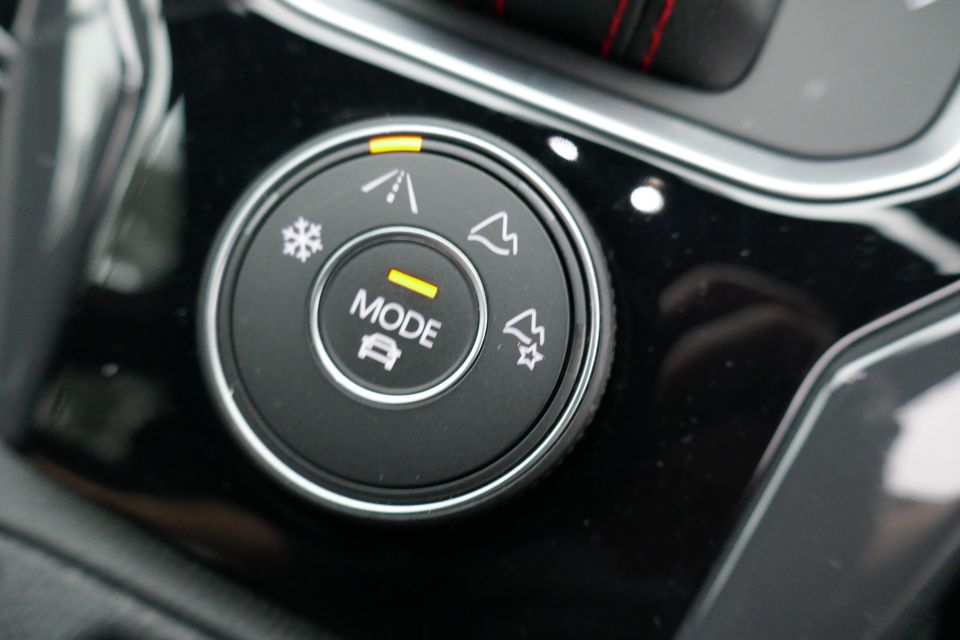
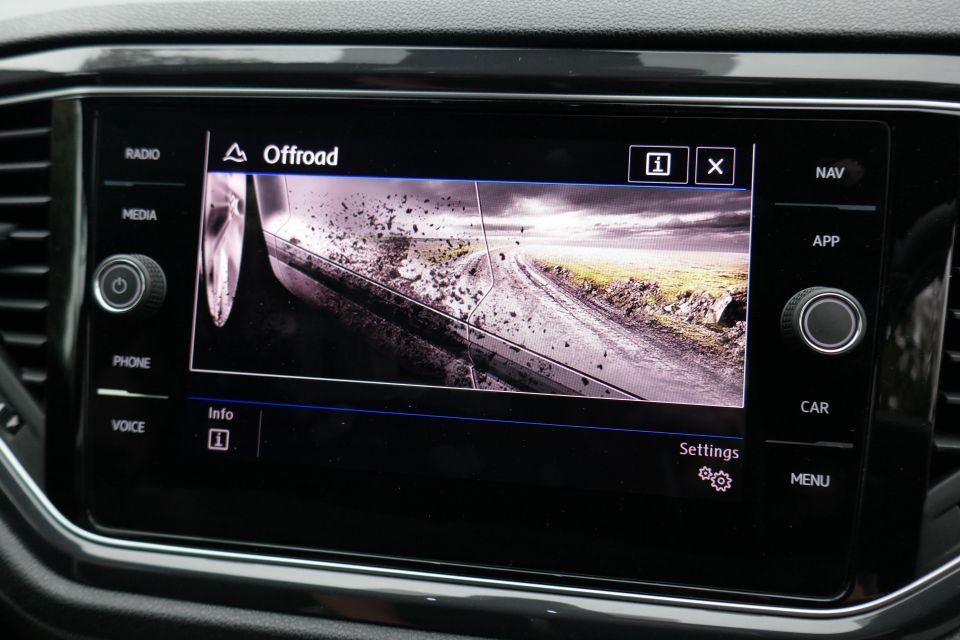

Volkswagen
The Volkswagen’s engine is a 2.0-litre petrol with a turbocharger. It’s low on frills compared to the Mazda’s trick ignition/24V system, but does a great job.
It’s mated to a seven-speed DSG dual-clutch automatic transmission and ‘4Motion’ active AWD.
Power (140kW at 4900rpm) and torque (320Nm at 1500rpm) are well up on the Mazda’s unit, and at the same time the Vee-Dub is 64kg lighter. That’s sufficient for a brisk, dare I say hot-hatch-lite 7.2 second 0-100km/h sprint time – almost two seconds faster than the Mazda’s 8.9-second figure.
The claimed fuel consumption using 95 RON fuel is 7.2L/100km, so 20 per cent inferior to the Mazda’s claim.
| Mazda CX-30 X20 Astina | Volkswagen T-Roc 140TSI | |
|---|---|---|
| Fuel type | 95 RON | 95 RON |
| Displacement | 2.0-litre | 2.0-litre |
| Peak power | 132kW @ 6000rpm | 140kW @ 4900-6000rpm |
| Peak torque | 224Nm @ 3000rpm | 320Nm @ 1500-4800rpm |
| Claimed fuel use | 6.0L/100km | 7.2L/100km |
| Our fuel use | 7.9L/100km | 9.4L/100km |
| Transmission | 6-speed auto | 7-speed DSG |
| Drive type | All-wheel drive | All-wheel drive |
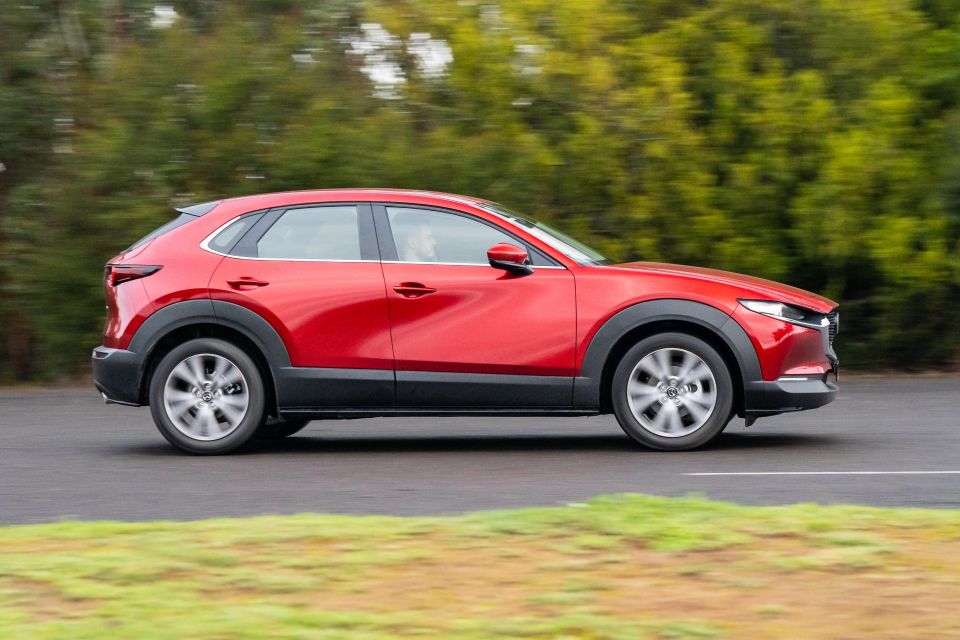
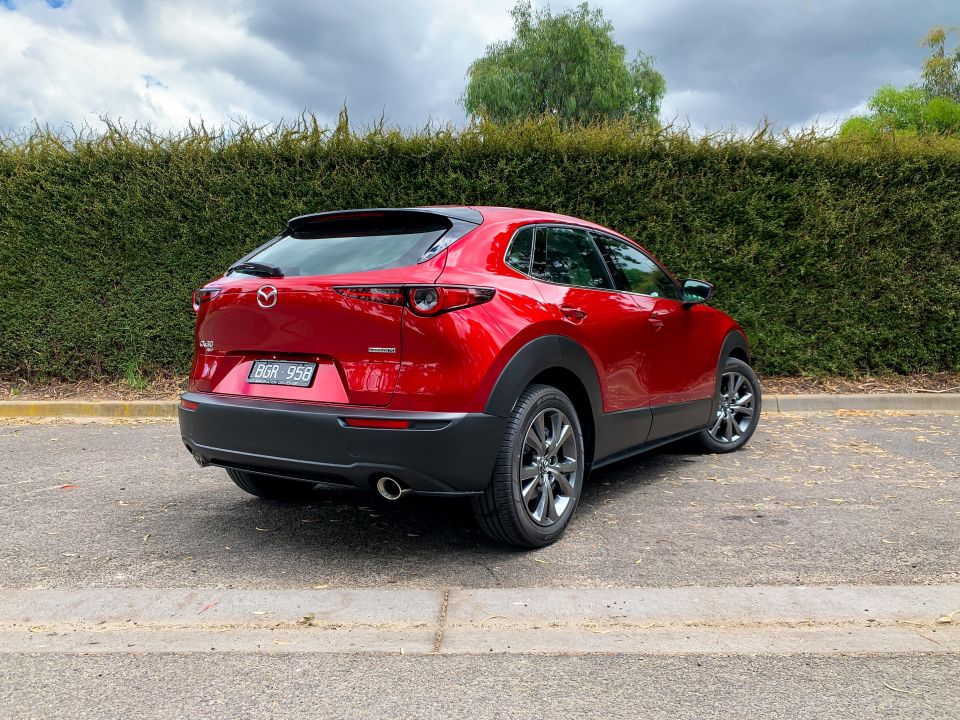
Mazda
Compared with non-Sky-X Mazda petrol engines, which flare their revs upon start-up to fast-track their way to operating temperature, the X20’s unit is rather refined.
The engine really comes alive north of 3000rpm, with an appreciable kick in the pants under decent throttle application. It has more low-down torque than many small-displacement atmo engines, but you’re not exactly surfing on a wave of diesel-like torque.
As is typical with Mazda, the transmission is generally well-sorted, with good ratio spacing and an aggressive sports mode there when the fancy takes you. The exhaust note is never inspiring, but it’s a free-revving engine.
You can watch an active diagram on the centre screen showing you the energy recuperation and combustion processes, but I can’t imagine many folks will.
I’m not convinced the 24V battery is enough to really make much difference, since the stop-start system (commendably smooth when operational) didn’t once engage when I had the air-conditioning going.

Unlike a full hybrid, don’t expect to drive through shopping centre car parks, or in reverse out of driveways, in silent electric mode either.
The magic question is: fuel economy? Not as good as we’d hoped, in short. I started with the fuel tank brimmed, drove 431km, brimmed it all the way back up and calculated my real fuel use by dividing distance travelled and litreage refilled. It was 7.98L/100km.
In terms of ride and handling, there’s a lot to like. Mazda has seemingly tuned the suspension to enable some natural-feeling but controlled body movement over bumps, and some feedback through the electric-assisted steering wheel, because you’re never that isolated from the road.
It’s rarely uncomfortable (occasional kickback aside), merely engaging. When driving harder, the chassis proves its dynamic worth, and the body control in cornering is more hatch than SUV. The torsion beam rear might lose road contact eventually, but keep in mind the target demographic.
It’s also quiet and refined at speed, since Mazda has applied great effort to NVH suppression and it shows. The exception to this is a propensity for the suspension to loudly hit the bump stops over really harsh hits – it’s not jiggly, just a little noisy.
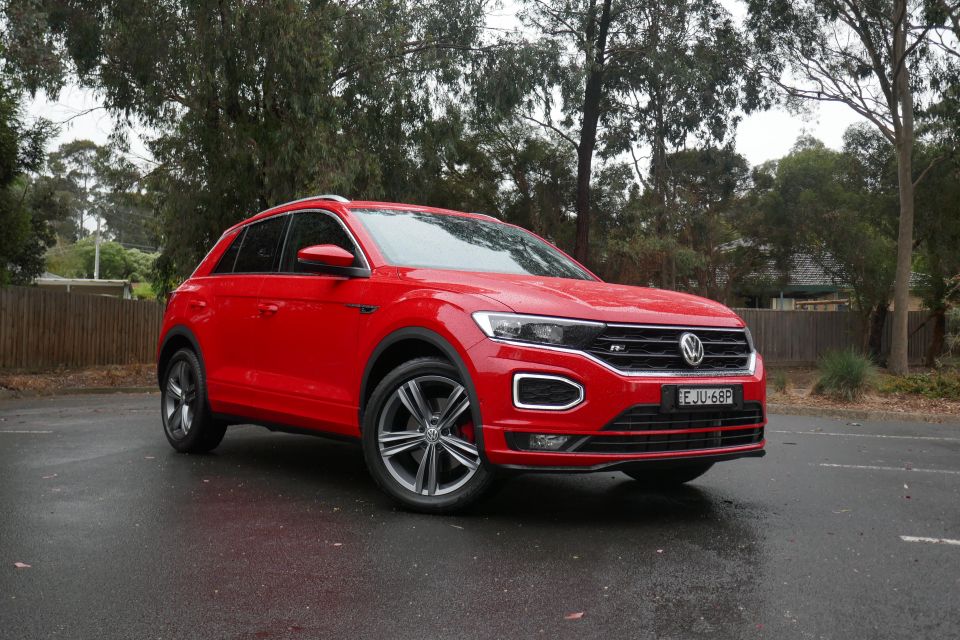
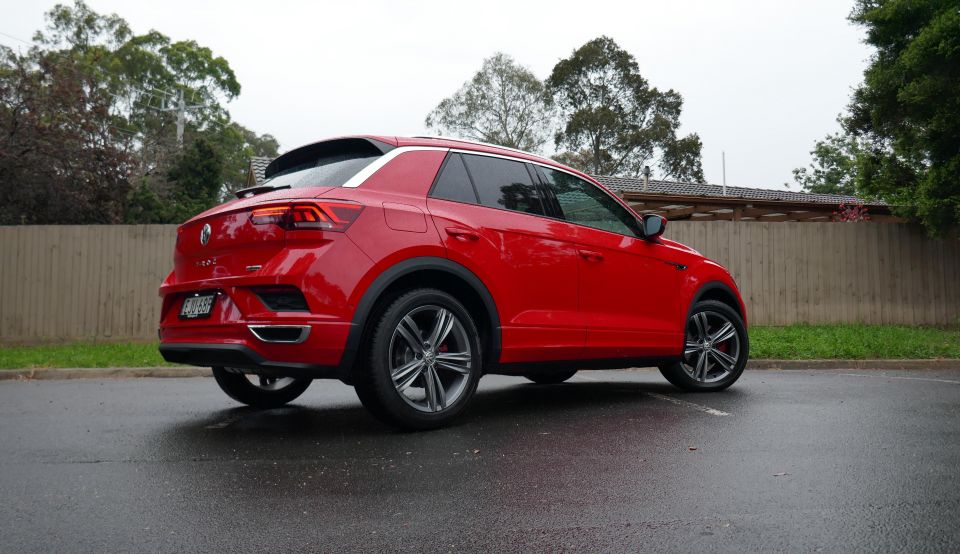
Volkswagen
If the Mazda is a plush little car-on-stilts, then the Volkswagen by contrast is a higher-riding hot hatch, down to its ‘MQB’ architecture/platform shared with the Golf.
That engine is a ripper, with reserves of pulling power on tap immediately, and little in the way of turbo lag. It’s deceptively muscular, and the slick-shifting DSG rifles through ratios nicely once you’re on the move. It’s also one of the more refined units.
As we said in our previous T-Roc review, it’s also nowhere near as noisy as we thought it might be under a heavy load. It’s a nice surprise because usually when you punch these small-displacement turbo engines the response can be the sound of a sewing machine.
I averaged fuel economy of 9.4L/100km doing similar driving to the Mazda, mostly in normal driving mode and occasionally trying the others (Sport tells the DSG to hold onto lower ratios, mostly).
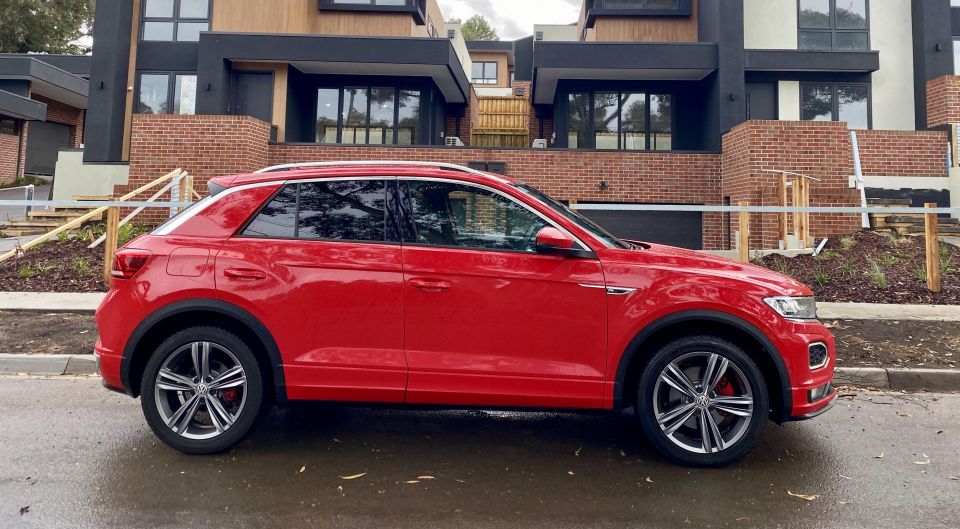
Where expert car reviews meet expert car buying – CarExpert gives you trusted advice, personalised service and real savings on your next new car.
It sits squat on the road, with direct sans-kickback steering, excellent handling, and a clever active AWD system that apportions torque to each end as needed, and has various modes to change the ESC tune, gearing, and throttle mapping, to better suit certain slippery surfaces.
The T-Roc is 84kg heavier and 130mm taller than the Golf GTI and dynamically it’s not quite in the same league, but it feels damn surefooted and light on its feet for a crossover. Fun to drive without being outright engaging is how we would describe the experience.
The ride quality as tested was at least as good as the Mazda’s – it feels smoother and more planted, but a little distinctively ‘alive’ for lack of a better descriptor.
But the addition of adaptive dampers with changeable compression/rebound force, alongside 19-inch wheels, should elevate the design and handling package another notch.
If you fancy a product that really puts the ‘Sport’ in ‘Sports Utility Vehicle’, then the T-Roc is more convincing than the plush and rather distinctive Mazda.
| Mazda CX-30 X20 Astina | Volkswagen T-Roc 140TSI | |
|---|---|---|
| Front suspension | MacPherson strut | MacPherson strut |
| Rear suspension | Torsion beam | Multi-link |
| Front brakes | Ventilated disc | Ventilated disc |
| Rear brakes | Solid disc | Solid disc |
| Turning circle | 10.6m | 11.1m |
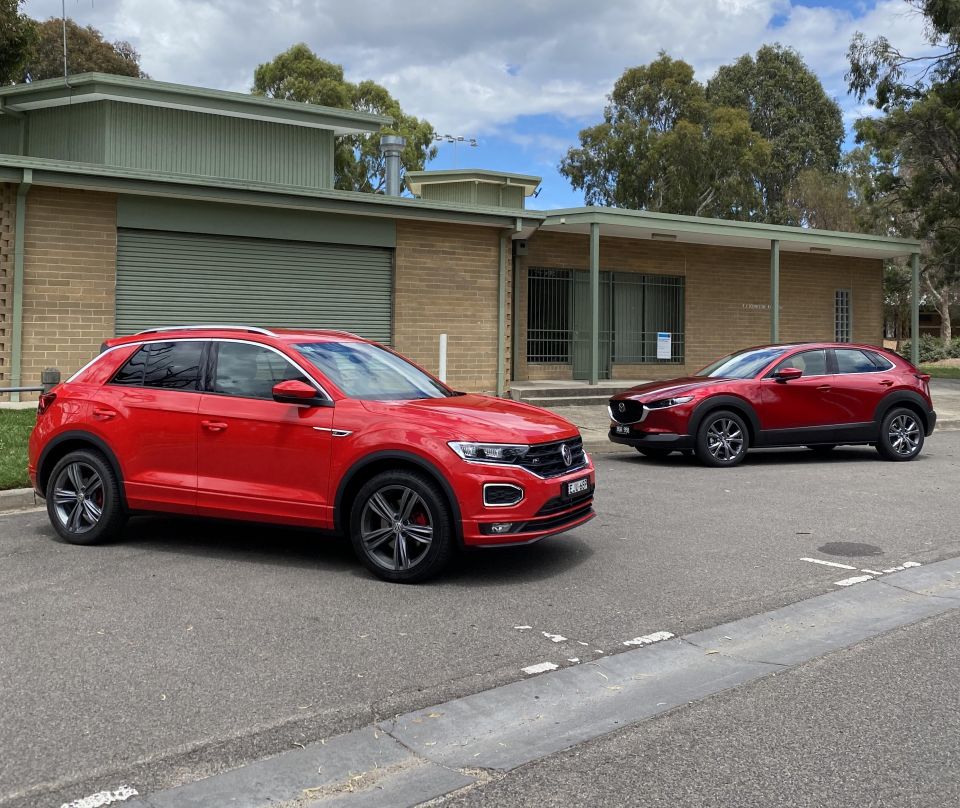
Both manufacturers offer five-year and unlimited-kilometre factory warranties, and have extensive dealer networks.
The Mazda’s servicing intervals are annual or 10,000km, and the first five visits cost (at current sums) $2052 all up including new brake fluid every two years and a new air filter at 40,000km.
By contrast Volkswagen will sell you a prepaid five-year Care Plan to service the T-Roc, totalling $2100 across the period, at intervals of 12 months or 15,000km between visits. You can pay as you go, but it’ll cost you an additional $696.


You pay a premium to get a sleek crossover SUV body over a comparable hatch, which represents dubious value. But if you’re committed to this course, which works better and why?
While I found myself seduced by the Mazda’s cabin and admire its engineering efforts – there’s a platform to build on – I think the T-Roc’s added practicality and sportier driving character, plus the pricing even with choice options added, renders it the winner if my money were on the line.
Keep in mind, though, there are various CX-30 spec grades to choose from that aren’t the X20 Astina, and in that sense you may find one that suits you better. This is especially true if you’ve a tactile disposition and aspire to a genuine semi-luxury product.
We didn’t film either of these specific cars, however we have published detailed videos on both the CX-30 and T-Roc previously, which we hope will assist your research.
We’ve also included our video review of the SkyActiv-X drivetrain fitted to the closely-related Mazda 3.
MORE: Mazda CX-30 news and reviews MORE: Volkswagen T-Roc news and reviews
Share your thoughts with us in the comments below!
Share your thoughts and write a review of a car you own and get featured on CarExpert.


Matt Campbell
6 Hours Ago


Max Davies
22 Hours Ago


William Stopford
22 Hours Ago


Derek Fung
22 Hours Ago


Max Davies
1 Day Ago


William Stopford
2 Days Ago